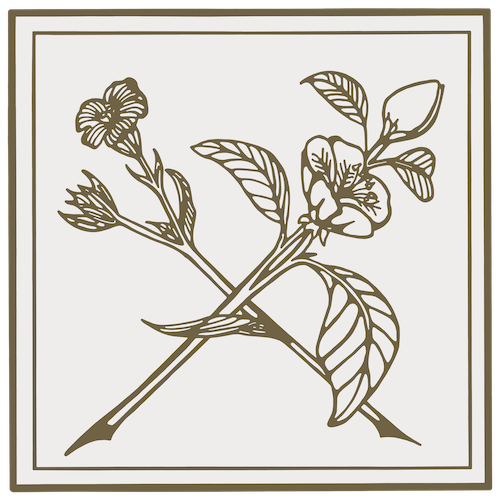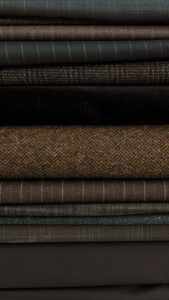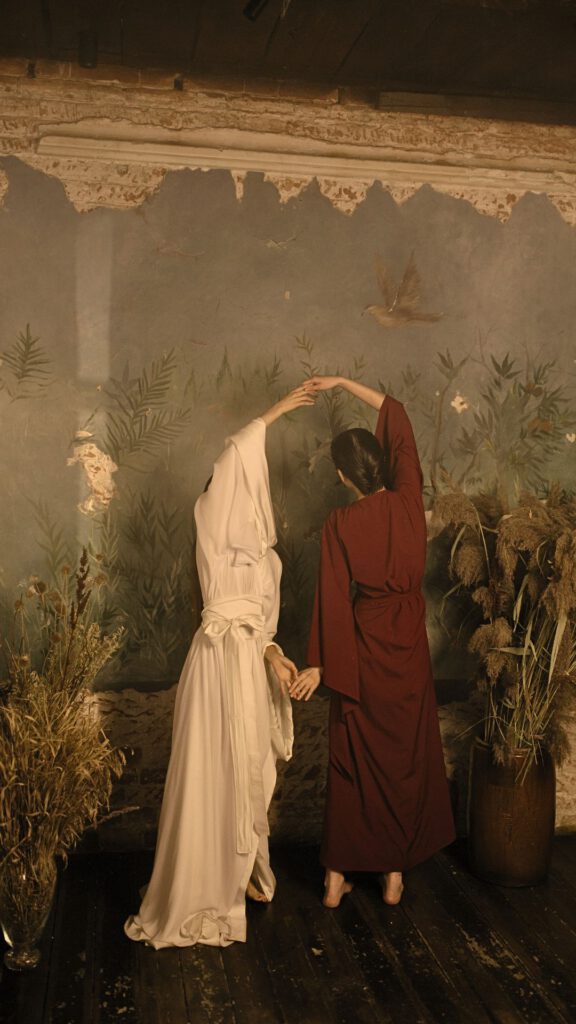Affiliate Disclosure
Some of the links on this page may be affiliate links. As an Amazon Associate, I earn from qualifying sales from these links. If you make a purchase or sign up for a membership through these links, I will receive a small commission. This will not cause any additional costs for you. This income helps us to run this website and especially the blog for you.
All about fabrics
As a designer, I often deal with different types of fabrics, which I use in the design of my designs. Nowadays we know countless types of natural and synthetic fabrics. From acrylic to mushroom leather, the existing possibilities are extremely exciting and versatile. In this post, I would like to give you an overview of the most common types of fabrics and briefly explain what they are best suited for. Feel free to take a look at my other Design-Basic articles, in which I present the most important facts and know-how on design-related topics.
1. Plant-based fabrics
In the case of vegetable substances, a rough distinction is made between seed fibres, bast fibres, hard fibres and fruit fibres. In general, the longer a single fiber is, the higher the quality or at least the more durable the fabric that can be made from it. Seed fibers are usually rather short fibers, such as cotton. Bast and hard fibres can grow up to 200cm long, e.g. ramie fibres. This makes fabrics made from these fibers very durable.
Linen
Linen is a natural fabric extracted from the fibers of the flax plant. Linen fabrics are very robust, breathable and skin-friendly. They are great for summer clothing such as trousers, skirts and blouses. Linen fabrics have a natural temperature regulation, which makes them very comfortable in summer. However, linen fabrics need to be cared for carefully and should not be washed too hot.
Hemp
Hemp is a natural substance extracted from the fibers of the hemp plant. Hemp fabrics are very robust, breathable and hard-wearing. They are great for garments that require a lot of movement, such as jeans or backpacks. Hemp fabrics have a natural temperature regulation that makes them very comfortable in summer. They are also relatively inexpensive and environmentally friendly, as hemp is a fast-growing plant that requires little water and can be grown without pesticides.
Nettle
Nettle is a natural substance extracted from the fibers of the nettle plant. Nettle fabrics are very robust, breathable and skin-friendly. They are great for summer clothing such as shirts, blouses, and dresses. Nettle fabrics have a natural temperature regulation that makes them very comfortable in summer. They are also relatively inexpensive and environmentally friendly, as nettle is a fast-growing plant and can be grown without pesticides. However, nettle fabrics must be cared for carefully and should not be washed too hot.
Cotton
Cotton is one of the most widely used fabrics in the textile industry. It is a natural fabric extracted from the fibers of the cotton plant. Cotton fabrics are soft, breathable and durable. They are great for t-shirts, blouses, dresses and bed linen. Cotton fabrics are easy to maintain and can be washed at high temperatures. They are also relatively inexpensive and come in a variety of colors and patterns.
2. Semi-synthetic fabrics
Semi-synthetic fabrics have a natural origin as a raw material. Often, for example, cellulose from wood waste. In most cases, they also have the great properties of natural fibers, but they usually require complicated chemical processes in their production. Unfortunately, this does not necessarily make them environmentally friendly and sometimes puts a strain on the health of the people involved in the production.
Vegetable silk
Vegetable silk, also known as Tencel or Lyocell, is a synthetic fabric derived from natural cellulose fibers, such as wood. Vegetable silk fabrics are soft, supple and have a smooth surface. They are highly breathable and absorbent, making them ideal for clothing such as shirts, blouses, and dresses. Plant silk fabrics are also environmentally friendly as they are made from renewable raw materials and can be produced in a closed-loop process.
Viscose
Viscose is a semi-synthetic fiber derived from natural cellulose, usually wood. Viscose fabrics are soft, supple and have a smooth surface. They visually resemble silk, making them a popular alternative to this expensive fabric. Viscose fabrics are very breathable and absorbent, which makes them good for garments such as blouses, dresses and skirts. They are also relatively inexpensive and come in a variety of colors and patterns. However, viscose fabrics should be cared for with care, as they are prone to creasing and in some cases only dry cleaning is recommended.
Acetate
Acetate is a synthetic fiber derived from natural cellulose, usually cotton or wood. Acetate fabrics are soft, shiny and have a smooth surface. They visually resemble silk, making them a popular choice for garments such as blouses, dresses, and especially linings. Acetate fabrics are lightweight and breathable, which makes them comfortable to wear. They are also relatively inexpensive and come in many colors. However, acetate fabrics should be cared for with care, as they are sensitive to heat and moisture and should generally only be dry-cleaned.
Modal
Modal is a semi-synthetic fiber derived from natural cellulose, usually beech wood. Modal fibers are soft, supple and have a smooth surface. They visually resemble viscose, so they are a good alternative to this fabric. Modal fabrics are highly breathable and absorbent, making them ideal for garments such as t-shirts, underwear, and sleepwear. They are also resistant to creasing and do not fade quickly. Modal fabrics can be washed at low temperatures and are relatively easy to care for.
2. Synthetic fabrics
Synthetic fabrics have become increasingly present over the last 50+ years. Their production is comparatively cheap, which has only just made the fast fashion boom that unfortunately still prevails possible. There are certainly also one or two positive aspects, e.g. in sportswear, special functional clothing has pleasant wearing properties at first, but they also love bacteria only too gladly, which is why this functional clothing in particular often quickly starts to smell unpleasant. The latter would rather not happen with a shirt made of merino wool.
Crude oil and various chemicals are also used in the production of synthetic fibers. Which is not environmentally friendly even in production. Especially with blended fabrics, there is also the problem that they are usually no longer recyclable. Not only do they emit micro- and nanoplastics with every wash, but they are non-degradable plastic waste at the end of their lives.
Polyester
Polyester is a synthetic fabric made from various plastic fibers. Polyester fabrics are very durable, wrinkle-resistant and easy to maintain. They are great for sportswear, outdoor clothing and bedding. Polyester fabrics are very quick-drying and can be washed at high temperatures. They are also relatively inexpensive and come in many colors and patterns.
Acrylic
Polyacrylic is a synthetic fiber made from acrylonitrile. Polyacrylic fabrics are soft, light and have good thermal insulation. They visually resemble wool, making them a popular alternative for people who want to avoid animal materials. Polyacrylic fabrics are wrinkle-resistant and keep their shape well. They are also relatively inexpensive and come in many colors and patterns. Polyacrylic fabrics can be washed at low temperatures, but should not be ironed too hot.
Polyamide
Polyamide, also known as nylon, is a synthetic fiber made from petrochemical raw materials. Polyamide fabrics are very strong, durable and lightweight. They are highly resistant to abrasion and tear resistance. Polyamide fabrics are also elastic and dimensionally stable, making them ideal for sportswear, swimwear and underwear. They are easy to maintain and dry quickly. Polyamide fabrics are available in a variety of colors and textures and can be washed at high temperatures.
3. Animal substances
Especially in the past, fabrics made from animal fibers were highly valued. They sometimes have great properties, such as thermoregulation, they are moisture-repellent or moisture-regulating, they can warm or cool and are usually also naturally repellent. Furthermore, they are environmentally friendly because they are compostable and no crude oil is used. Unfortunately, there are of course also downsides to animal products, because not all sources are animal-friendly, but there are definitely companies that pay a lot of attention to animal welfare.
Silk
Silk is a very noble and high-quality fabric obtained from the cocoons of silkworms. Silk fabrics are very soft, smooth and slightly shiny. They are very comfortable to wear and are great for evening dresses, blouses and scarves, but also luxurious bedding. Silk fabrics have natural temperature regulation that makes them comfortable in both summer and winter. However, silk fabrics must be cared for carefully and must not be washed too hot.
Wool
Wool is a natural substance obtained from the hair of sheep, goats or camels. Wool fabrics are very warm, soft and breathable. They are great for winter clothing such as coats, jackets, and sweaters. Due to their natural insulating properties, wool fabrics are ideal for cold weather. However, wool fabrics need to be cared for carefully and should rarely be washed by hand or, depending on the garment, only dry cleaned. Popular wool fibres are, for example, merino wool, alpaca or cashmere.
4. Fabrics by type of manufacture or weave
There are many different weaves that can be used to make fabrics. In the following, I will give you some examples of common weaves.
Top
Lace is a very fine and noble fabric made from yarns or threads. Lace fabrics are very transparent and often have a filigree pattern. They are great for evening dresses, lingerie, and accessories such as scarves and shawls. Lace fabrics are very delicate and need to be cared for carefully. They must not be washed or ironed too hot.
Twill
Twill weave is a weave in which the threads run at an angle and form a diagonal line. This weave is often used for denim fabrics, such as jeans. The twill fabric is robust, hard-wearing and has a slightly rough surface.
Satin weave
Satin weave is a weave in which the threads are woven together in such a way that the surface appears smooth and shiny. Satin fabrics are very supple and soft. They are often used for elegant garments such as evening dresses and blouses.
Jacquard weave
Jacquard weave is a complex weave in which complex patterns and designs are woven into the fabric. This weave allows the creation of detailed and multi-colored patterns on the fabric. Jacquard fabrics are often used for high-end clothing, home textiles and upholstery fabrics.
Plain weave
Plain weave is a simple and sturdy weave in which the threads alternately run over and under the other threads to form an even and firm weave. Plain weave is often used for cotton fabrics, such as canvas. The fabric is hard-wearing and long-lasting, which is why it is often used for bags, backpacks and furniture covers.
Panama Bond
Panama weave is a weave in which fine threads are intertwined into a dense weave to create a textured pattern. Panama fabrics are lightweight and breathable, which is why they are well suited for summer clothing such as shirts, blouses and dresses. This weave is often used for cotton fabrics and gives the fabric an interesting texture.
Conclusion
There are many different types of fabrics, all of which have their own advantages and disadvantages. Above all, it is important to choose the right type of fabric for the particular garment or interior design project. Choosing the right fabric can make a big difference in terms of comfort, appearance, and durability. I hope that I was able to give you an overview of the most important types of fabric with this post and that I can support you with your next choice of clothes or maybe even your next sewing project.
I wish you a relaxing weekend!
All the love
Christina
“We are made of such stuff as dreams are, and our little life is surrounded by sleep.”
William Shakespeare
Share this post:

We’re excited
to share our news with you!
Would you like to receive information about our latest articles and our latest products directly in your mailbox?
Sign up for our newsletter!
We’d love to keep you in the loop.



